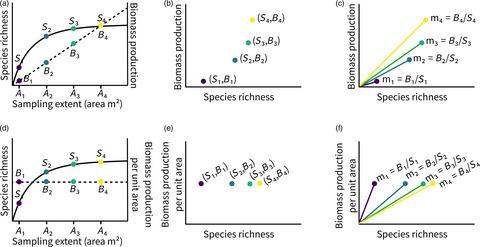Our official English website, www.x-mol.net, welcomes your
feedback! (Note: you will need to create a separate account there.)
A graphical null model for scaling biodiversity–ecosystem functioning relationships
Journal of Ecology ( IF 5.3 ) Pub Date : 2020-12-22 , DOI: 10.1111/1365-2745.13578 Kathryn E. Barry 1, 2, 3 , Gabriella A. Pinter 4 , Joseph W. Strini 4 , Karrisa Yang 4 , Istvan G. Lauko 4 , Stefan A. Schnitzer 5 , Adam T. Clark 1, 6, 7 , Jane Cowles 8 , Akira S. Mori 9 , Laura Williams 10 , Peter B. Reich 10, 11 , Alexandra J. Wright 12
中文翻译:

用于扩展生物多样性与生态系统功能关系的图形化零模型
更新日期:2020-12-22
Journal of Ecology ( IF 5.3 ) Pub Date : 2020-12-22 , DOI: 10.1111/1365-2745.13578 Kathryn E. Barry 1, 2, 3 , Gabriella A. Pinter 4 , Joseph W. Strini 4 , Karrisa Yang 4 , Istvan G. Lauko 4 , Stefan A. Schnitzer 5 , Adam T. Clark 1, 6, 7 , Jane Cowles 8 , Akira S. Mori 9 , Laura Williams 10 , Peter B. Reich 10, 11 , Alexandra J. Wright 12
Affiliation

|
- Global biodiversity is declining at rates faster than at any other point in human history. Experimental manipulations at small spatial scales have demonstrated that communities with fewer species consistently produce less biomass than higher diversity communities. Understanding the consequences of the global extinction crisis for ecosystem functioning requires understanding how local experimental results are likely to change with increasing spatial and temporal scales and from experiments to naturally assembled systems.
- Scaling across time and space in a changing world requires baseline predictions. Here, we provide a graphical null model for area scaling of biodiversity–ecosystem functioning relationships using observed macroecological patterns: the species–area curve and the biomass–area curve. We use species–area and biomass–area curves to predict how species richness–biomass relationships are likely to change with increasing sampling extent. We then validate these predictions with data from two naturally assembled ecosystems: a Minnesota savanna and a Panamanian tropical dry forest.
- Our graphical null model predicts that biodiversity–ecosystem functioning relationships are scale‐dependent. However, we note two important caveats. First, our results indicate an apparent contradiction between predictions based on measurements in biodiversity–ecosystem functioning experiments and from scaling theory. When ecosystem functioning is measured as per unit area (e.g. biomass per m2), as is common in biodiversity–ecosystem functioning experiments, the slope of the biodiversity ecosystem functioning relationship should decrease with increasing scale. Alternatively, when ecosystem functioning is not measured per unit area (e.g. summed total biomass), as is common in scaling studies, the slope of the biodiversity–ecosystem functioning relationship should increase with increasing spatial scale. Second, the underlying macroecological patterns of biodiversity experiments are predictably different from some naturally assembled systems. These differences between the underlying patterns of experiments and naturally assembled systems may enable us to better understand when patterns from biodiversity–ecosystem functioning experiments will be valid in naturally assembled systems.
- Synthesis. This paper provides a simple graphical null model that can be extended to any relationship between biodiversity and any ecosystem functioning across space or time. Furthermore, these predictions provide crucial insights into how and when we may be able to extend results from small‐scale biodiversity experiments to naturally assembled regional and global ecosystems where biodiversity is changing.
中文翻译:

用于扩展生物多样性与生态系统功能关系的图形化零模型
- 全球生物多样性的下降速度比人类历史上任何其他时候都要快。在较小的空间尺度上进行的实验表明,物种较少的社区比生物多样性较高的社区持续产生较少的生物量。要了解全球灭绝危机对生态系统功能的影响,就需要了解局部实验结果可能会随着时空尺度的增加以及从实验到自然组装系统的变化而变化。
- 在不断变化的世界中跨时空扩展需要基线预测。在这里,我们使用观察到的宏观生态模式(物种-面积曲线和生物量-面积曲线)为生物多样性-生态系统功能关系的面积缩放提供了一个图形化的空模型。我们使用物种-面积和生物量-面积曲线来预测物种丰富度-生物量之间的关系可能会随着采样范围的增加而改变。然后,我们使用来自两个自然组装的生态系统的数据来验证这些预测:明尼苏达州的热带稀树草原和巴拿马的热带干旱森林。
- 我们的图形化零模型预测,生物多样性与生态系统的功能关系与规模有关。但是,我们注意到两个重要的警告。首先,我们的结果表明,在基于生物多样性-生态系统功能实验的测量结果和基于比例理论的预测之间存在明显的矛盾。当按单位面积衡量生态系统功能时(例如每m 2的生物量)),这在生物多样性-生态系统功能实验中很常见,生物多样性生态系统功能关系的斜率应随规模的增加而减小。或者,如按比例尺研究中所常见的,如果未按单位面积测量生态系统功能(例如,总生物量总和),则生物多样性与生态系统功能关系的斜率应随空间规模的增加而增加。第二,生物多样性实验的基本宏观生态模式与某些自然组装的系统可以预见地有所不同。实验的基本模式与自然组装的系统之间的这些差异可能使我们能够更好地了解何时生物多样性-生态系统功能实验的模式在自然组装的系统中有效。
- 综合。本文提供了一个简单的图形化无效模型,可以将其扩展到生物多样性与任何在空间或时间上起作用的生态系统之间的任何关系。此外,这些预测为我们如何以及何时能够将小型生物多样性实验的结果扩展到生物多样性正在变化的自然组装的区域和全球生态系统提供了重要的见识。











































 京公网安备 11010802027423号
京公网安备 11010802027423号